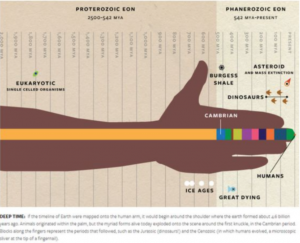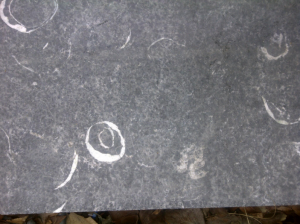The second session in the 3rd week about ‘deep time’ started with a deep lack…of students. Communication distortion on both, receiving and sending ends, prompted three students and one teacher to end up in the wrong classroom. Because time is a fleeting thing, the speaker of today’s session, João Trabucho Alexandre, decided to start by introducing himself. Alexandre is a geologist and interested in the deposition of mud into the ocean. In other – and more mysterious – words: rocks speak to him. The story they tell is about forever moving tectonic plates and always changing landscapes.
His goal for the session is to give us a new understanding of time, to make us familiar with ‘deep time’. One good method to better comprehend earth’s age is to stretch out your arm and imagine that the length from the centre of your chest to the tip of your fingernail represents the time from the big bang till our present. Now, when you follow this line with the fingers of your other hand and reach the middle of your stretched fingernail than you reached the time when human species started their reign on earth. With a small cut of your fingernail, human history disappears.

Image 1: Deep time at your fingers’ tip
The oldest subsurface in the Netherlands is about 400 million years old (Silurian Period). At that time, the land that later will become the nation of the Netherlands was still located where Surinam is now. Basically, the Netherlands is still a delta of the Rhein and Maasen. After the last big Ice Age the sea-level rose ‘quickly’; every year the coastline moved 100 meters! But, once the poles were melted the ‘great’ deluge receded, leaving behind very fertile land. This was the starting point for agriculture.
The tour
Every Dutch person uses 25 kilos of sand per year. For what you may ask? Mainly for the sublation of the coastline and renewing of buildings.
Starting our tour at Janskerhof, Alexandre pointed out that many houses in Utrecht are furnished with stones from other countries, e.g. Germany or Belgium. The little stairs leading to the entrance of building fifteen is granite and probably from Belgium. Granite is a limestone from the Carbonate Period. If you look closely you can see stems from corals or sea lilies. The next building we examined was the post office on the Neude. The art style in which it was built is called Amsterdam School. At that time, it was popular to use bricks and natural stone. The greyish, natural stone is a shell limestone originated from Trier, Germany. It’s called “Muschelkalk” and is about 250 million years old.

Image 2: Granite
At last, we looked at the stone outside of the Neude Flat. This stone is probably from Scandinavia and it’s a metamorphic style of stone. The original rock was sedimentary, maybe claystone, which then was pressured and under really hot temperature. Its structure is made out of thin plates that can be broken quite easily into pieces. Alexandre guessed that it originates from Precambrian times (500million years). In that era, all life consisted of bacteria. One of them, the Cyanobacteria produced free molecules of oxygen through photosynthesis. For other bacterias this oxygen was poison. The “Oxygen Crisis” caused the first great mass extinction in the history of the earth called. The organisms that prospered under these new circumstances were those who were able to use oxygen for their metabolism. Our ancestral lineage.

Image 3: “Muschelkalk”

Image 4: Types of metamorphic rocks
The end or beginning
One of the reasons why I picked this session was because of Alexandre’s talk. Alexandre referred to Stephen Gould who detected that the idea, that evolution is a linear process from simple to more complex living organisms, is a misconception. Gould’s book with the cheesy title ‘Wonderful Life’ is a critic against the seemingly inevitable determinism of evolution; i.e. that the evolution unfolded the way it did because of the working of natural selection. If this is the case, evolution and its outcomes would be predictable. But unpredictable variables, like the Oxygen Crisis or the Cambrian Explosion, show that this isn’t the case. Next to natural selection, other factors play a role (e.g. random drift, random mutation). The philosopher John Beatty refers to Gould’s criticism and asks accordingly “could the evolution have happened differently?” in his paper “Replaying Life’s Tape”
I’m fascinated by the evolution theory. Every time I’m sure that I fully understood it, it starts to confuse me again. To get hold of the series of events and their causal-dependancy resembles not only the work of a scientist but also of a historian. For Beatty, evolutionary biology is as much “science” as it is “history”. For me, geology has that in common with biology. Both use subjects (living organisms, rocks) as their witnesses, which are in a state of flux. Both deal with incomplete records. In the end, both disciplines raise issues about the concepts of contingency, time and necessity that we uphold. Geology offers a treasure of stories that we could tell through our Time Machine project. In the end, in some way, our existence, too, is virtual reality. It is one of many, that could have happened. A reality, that is not solely the product of nature’s predicaments, but of chance and choice too. To say it in other – more mysterious – words: life is nature’s play.
Sources
Literature
1) Gould, S. J. (1989). Wonderful Life. W.W. Norton & Co, New York.
2) Beatty, J 2006, ‘Replaying Life’s Tape’, The Journal of Philosophy, vol. 103, no. 7, pp. 336-362.
Images
1) Gould, S. J. (1987). Time’s Arrow, Time’s Cycle. Harvard University Press, Harvard.
2) Spencer, R 2012, Yes, I am Giving You a Hint of What that Thing Is, Irish Limestone US, viewed 3 October 2019, .
3) Hofmann, Hofman Naturstein, viewed 3 October 2019, . 4) Annenberg Foundation, 2017, Grace’s Rock Site, viewed 3 October 2019, .
By Nayra Hammann